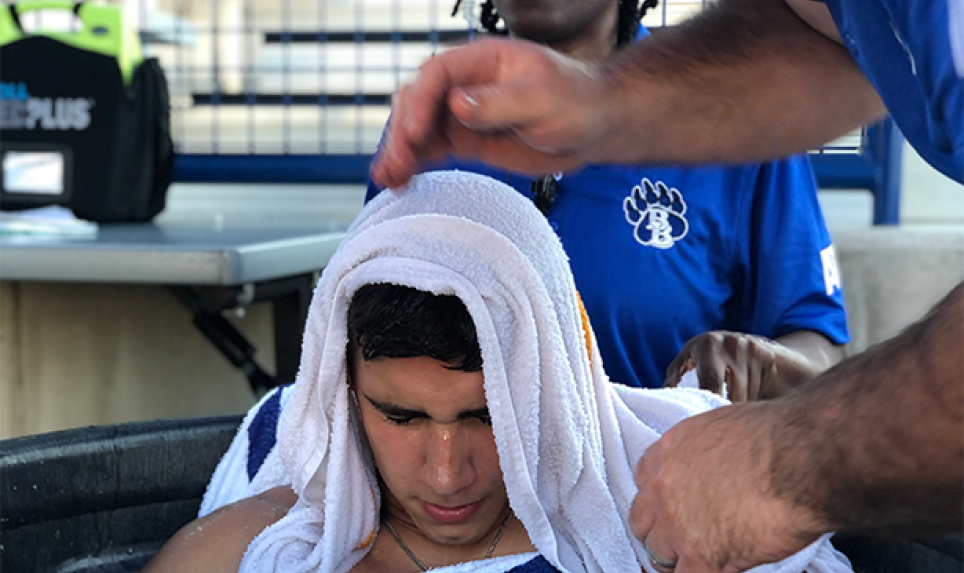If you have a student athlete in your home, you know the fall sports season is here. This season ushers in new schedules, physical and mental demands, teammates, coaches and hopefully athletic trainers. The athletic trainer is the person you may see running onto the field or court to check on an injured athlete or providing hydration to your athlete on the sideline or bench. But, behind the scenes they are also a confidant, encourager, advocate and the person responsible for your student athlete’s health and well-being. Their job does not stop when the time clock on the scoreboard hits zero. Athletic trainers are health care professionals who are passionate about keeping their patients as safe and as healthy as possible at all times. During all seasons, but especially in the fall, athletic trainers are particularly concerned with the health of their student athletes as it relates to heat illness. Temperatures can range well into the 90’s or 100’s in almost every area of the country, so athletic trainers give extra attention to both preventing and managing heat illnesses.
Just as a student athlete prepares for competition long before game day, so do athletic trainers. Athletic trainers take every precaution to prevent heat illness.
MONITOR PLAYING CONDITIONS
ATs use equipment such as a Wet-Bulb Globe Temperature (WBGT) device, which measures ambient temperature, relative humidity, wind speed and radiation from the sun for the most accurate information of environmental conditions that student athletes may perform in. If environmental conditions put student athletes at an increased risk of developing heat illness, the athletic trainer will work with coaches or the athletic director to modify, reschedule or cancel the event.
INFLUENCE HEAT ACCLIMATIZATION
ATs are trained and educated in heat acclimatization – or simply, the amount of time needed to allow the human body to adapt and perform in stressful weather conditions. The heat acclimatization process typically takes between 7 to 14 days. During this time, the student athletes adjust to environmental conditions, practice length, rest breaks, use of equipment and amount of contact drills. ATs influence heat acclimatization policies with best practice recommendations at the school, state and national level, working collaboratively with coaches, athletic directors (ADs) or league leadership.
EDUCATE ON SIGNS AND SYMPTOMS
Another way that ATs reduce the risk of exertional heat illness is making sure that student athletes, coaches, ADs and parents are aware of the signs and symptoms of the various types of exertional heat illness. Being aware of warning signs and acting appropriately to acquire care for the student athlete will save lives.
ENCOURAGE HYDRATION AND NUTRITION
Athletic trainers play an important role in developing unique hydration strategies for each student athlete. During practices and competition, athletic trainers make sure that water, electrolyte replacement and cooling areas are readily available. Keeping cool and hydrated helps the student athlete from becoming overheated and potentially developing heat illness. Unfortunately, despite meticulous preparation and planning, occasionally heat illness still occurs. The good news is that athletic trainers are experts in both identifying and managing heat illness, ensuring fast and best practice intervention.
Athletic trainers are also well trained in managing heat illness.
PREPARE FOR THE WORST
Appropriate equipment is one of the first lines of defense in treating heat illness. If you visit a fall practice or game, you should see an emergency heat station that includes a shade tent complete with water, electrolyte replacement, misters, ice packs, ice baths, rectal thermometers, an automatic electronic defibrillator (AED) and potentially oxygen support. Cold water immersion in a large gallon tub is one of the most effective ways to treat exertional heat illness. This $150 investment could save a student athlete’s life.
TAKE ACTION
When an athletic trainer sees a student athlete showing signs of exertional heat stroke (the most extreme form of exertional heat illness), they will remove the student athlete from play and bring them in to a shaded area, remove equipment and excess clothing and begin vigorously cooling the student athlete. Student athletes who are suffering from heat stroke should always be cooled first and transported second. While cooling a student athlete in a tub of ice water may seem like an easy task, EMTs, paramedics, coaches and ADs may not have the proper training to manage a heat related emergency, which is why it is vital to have athletic trainer at all practices and games.
For other less severe forms of heat illness, athletic trainers rely on their education, training and clinical experience to treat the student athlete. Following a heat related emergency, athletic trainers work with parents, coaches and physicians to return the student athlete to play, making sure that it is safe for them to do so. The return to play process is continually monitored to ensure the student athlete’s safety. Heat illness, although preventable and manageable, can be deadly. Athletic trainers are there to keep your student athlete safe, healthy and in the game, but they need the parent’s support.
Here are some ways parents can help keep student athletes safe in the heat:
ENCOURAGE YOUR STUDENT ATHLETE
Encourage your student athlete to stay hydrated, learn the symptoms of heat illness and to speak up when they recognize when they or a teammate are potentially suffering from heat illness.
COMMUNICATION IS KEY
Talk to your student athlete about establishing and maintaining a relationship with their athletic trainer. Communicate with your student athlete’s athletic trainer and support the athletic training staff.
ASK QUESTIONS
Perhaps the most important thing you can do as a parent is ask questions. Research shows that nearly ONE THIRD of schools have no athletic trainer for their student athletes. If your team or school does not have an AT, now is the time talk to your youth sport organization or school administration about investing in the health and safety of your student athlete.
